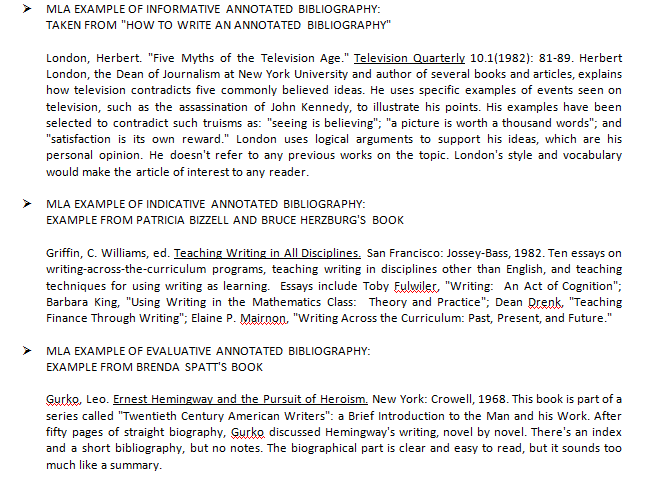Annotated Bibliography overview:
What is annotated bibliography?
A bibliography is a list of sources such as books, journals, Web sites, periodicals, etc. which one has used for topic research. Bibliographies are often known as “References” or “Works Cited” depending on the format being used. A bibliography usually just includes the bibliographic information i.e. the author, title, publisher, etc.
An annotation is a summary and/or evaluation which provides a brief account of the research on a given topic. It is a list of research sources that might also include concise descriptions and evaluations of each source. It usually contains a summary of content with a short analysis or evaluation.
An annotated bibliography may be a component of a larger project or it can also be a stand-alone assignment. While an annotation can be as brief as one sentence, on the other hand, the standard annotated bibliography can consist of a citation followed by a short paragraph.
The purpose of annotated bibliography:
Depending on the specific assignment you are working on, an annotated bibliography might include:
- The literature review of a subject in specific
- demonstrating the quality and depth of reading that has been done by you before writing
- exemplify the scope of sources that were available—such as journals, books, websites, magazine articles, etc.
- highlight the sources that you think may be useful and in the interest of other readers and researchers
- explore and organize the sources for further research work
When you are set on an assignment, an annotated bibliography gets you acquainted with the material available on a topic.
Organization of annotated bibliography:
If not prescribed by faculty, the organization of the annotated bibliography may include one of the below methods but is not limited to these.
- Alphabetically
- Chronological order: either by date of publication or by a period of subject matter
- Subtopic
- Format: articles, books, government documents, media, web pages and much more.
- Language used
Structure of annotated bibliography:
Find and record citations from various sources on your topic
What types of sources should you be looking for?
- One good rule is to have some primary sources (original texts, research reports, or documents) and secondary sources (an academic journal where a learned author has analyzed other’s work). In the sciences, where scientists are reporting their own research are primary sources.
- For a quick start try to find published bibliographies.
- Look at reference lists – repeated names indicate that these are essential sources and should be included in your bibliography.
- While using a database, note down the keywords or synonyms and use it to find materials that are related to your work.
- Use citation manager to collect citations and record summaries.
- Start with scholarly works first as it will give you a good grounding and provide context for the rest of your entries.
How can you evaluate your sources while reading?
- Filter and scan the abstracts, prefaces, tables of contents, and indexes to see if it will be useful for you and remember to check for synonyms to describe your topic.
- Take notes as you read specifically of bibliographic details, a summary of contents, notations of methodology, theoretical perspective, pertinence to your project, and biographical data (about the author), you may also take photocopies and keep it with you.
- Make a chart. On the side write down the names of the authors and texts, along with important sub-topics. This will help you to compare and contrast the value of the works of various authors.
Choose how you will organize your annotated bibliography
- There are three most common ways of organizing your annotated bibliography: alphabetically, by date, and by subtopics or sections. The latter will not be useful in a very short paper.
- Decide whether you need to write a paragraph as a preface, explaining the scope of your annotated bibliography. Mostly, undergraduate annotated bibliographies are short and simple.
Write your annotations and save them in a file
- As you read each work, compose a finished annotation for that text and proofread with the text in front of you.
- Check for any errors and save your entry as a draft of your paper. Don’t just make brief notes as later you may not remember what you meant when you made that note.
- After finishing a few entries, check to see that that the taxonomy and annotation style is appropriate for your purpose.
- Make all your entries consistent, revise what you have done to check if it’s appropriate, and continue to create the rest of your annotations with the first entry serving you as a guide.
After you have written your first draft, check it over
- First, check each citation for accuracy, consistency and major focus points of the text? Make sure that you have not mixed the two types of annotated bibliography.
- Recheck your assignment instructions and ensure that you have included all the elements you need in each annotation. Maybe a checklist can be of help here, to compare each entry against the list.
- Read thoroughly for errors in grammar, punctuation, and style, and be sure to note any odd spellings of names.
- Check your tenses and be as consistent as is logically possible – historical present tense is most commonly used.
- Avoid passive voice where ever possible.
- Avoid using quotations, except when the words quoted are important terms to highlight.
- Look over your work to see if you have used any key annotation verbs such as demonstrates, asserts, speculates etc.
Type of annotated bibliographies:
APA Annotated bibliography:
In APA style the titles starting with articles (“a” and “the”; and it’s equivalents in other languages), the article is not considered for organizing in alphabetical order. But, numerals and numbers are sorted in an alphabetized manner as they are spelled out.
What to include:
In APA style, every citation in your text must be reflected in an entry on the references page except personal communications with the author such as e-mails, conversations, and letters which should only be cited in the text.
Likewise, every item on the references page should reflect in-text citation somewhere in your work.
Remember not to include works that you do not cite in the body of your paper.
Rules: The Publication Manual of the American Psychological Association (6th ed.) states the following formatting rules:
- The text and the reference list should be double-spaced.
- Numbering should start on the title page, at the top right corner of the page.
- Reference list entries must have a hanging indent.
- There should be 1 inch (2.54 cm) margins all around on each page.
- Use Times Roman font or similar font.
- Each paragraph should be indented.
The following example uses APA style (Publication Manual of the American Psychological Association, 6th edition, 2010) for the journal citation:
Waite, L. J., Gold Schneider, F. K., &Witsberger, C. (1986). Non family living and the erosion of traditional family orientations among young adults. American Sociological Review,51, 541-554.
The authors, researchers at the Rand Corporation and Brown University, use data from the National Longitudinal Surveys of Young Women and Young Men to test their hypothesis that non family living by young adults alters their attitudes, values, plans, and expectations, moving them away from their belief in traditional sex roles. They find their hypothesis strongly supported in young females, while the effects were fewer in studies of young males. Increasing the time away from parents before marrying increased individualism, self-sufficiency, and changes in attitudes about families. In contrast, an earlier study by Williams cited below shows no significant gender differences in sex role attitudes as a result of non family living.
MLA Annotated bibliography:
In MLA style citations are sorted in alphabetical order whereas numbers in titles are treated as though they have been spelled out.Ignore any special characters (like with @) that might appear before a name. If the title begins with a number, alphabetize it (for example, consider “1” as “One”).
What to include:
The title “Works Cited” indicates that the citation list contains only the works you actually cite in your paper. If you wish to also include the works that you consult but do not cite, keep it under the title “Works Consulted.”
Rules: The MLA Handbook for Writers of Research Papers states the following formatting rules:
- The text and the works cited list should be double-spaced.
- Number your pages at the top right of the page.
- Reference list entries must have a hanging indent.
- There should be 1 inch (2.54 cm) margins all around (top, bottom, left, and right) on each page.
- Use Times Roman font, or a similar serif font.
- Capitalize each important word (noun or verb) in a book or article title
- Each paragraph should be indented.
 Chicago Annotated bibliography:
Chicago Annotated bibliography:
Citations beginning with names and those beginning with titles are to be alphabetized together. Numbers in titles are treated as though they have been spelled out. For names, alphabetize based on the letters that come before the comma separating the last name from the first, and disregard any spaces or other punctuation in the last name. For titles, ignore articles such as “a” and “the” (and equivalents in other languages) for alphabetization purposes.
What to include:
The reference list should contain only works that are cited in the body of your paper. Newspaper articles are often omitted from the works-cited page; personal communications with the author are generally omitted as well. In these cases, a citation note should be included in the body of the paper.
Rules: The Chicago Manual of Style states the following formatting rules. Check your assignment description for other instructions in case your instructor gave.
- The text should be double-spaced.
- Numbering starts on the first page of writing (not the title page), at the top right of the page.
- Reference list entries must have a hanging indent.
- There should be 1 inch (2.54 cm) margins all around (top, bottom, left, and right) on each page.
- Use Times Roman font, or a similar serif font.
- Each paragraph should be indented using the tab key.
This example uses Chicago style for the journal citation:
Davidson, Hilda Ellis. Roles of the Northern Goddess. London: Routledge, 1998.
Davidson’s book provides a thorough examination of the major roles filled by the numerous pagan goddesses of Northern Europe in everyday life, including their roles in hunting, agriculture, domestic arts like weaving, the household, and death. The author discusses relevant archaeological evidence, patterns of symbol and ritual, and previous research. The book includes a number of black and white photographs of relevant artifacts.
This annotation includes only one paragraph, a summary of the book. It provides a concise description of the project and the book’s project and its major features.
Annotated bibliography maker/generator:
Can I use software programs to create my annotated bibliography? Why should I consider doing that?
The use of reference software programs is an optional way of storing bibliographic entries in a database format. While annotated (and other) bibliographies can also be created in a word processing program, there are certain advantages to building and storing bibliographic entries in database software programs like EndNote,Ref Works, or Style Writer. Each of these programs allows the user to link complete reference information on a source to a list of keywords, an annotation, and/or notes fields in which you can enter specific and personalized information about the work and its relevance to your own area of inquiry. Over time, these programs can allow you to build a virtual “library” of references relevant to one or more research topics, and they can be recalled and accessed later as needed through specific keyword searches. When embarking on a lengthy research project like a dissertation, the ability to save annotated sources in a thematically retrievable way is invaluable in that it enables you to locate the sources most relevant to any aspect of the project you might be working on, as well as simultaneously recalling your own notes on the content of those sources.
Can’t I just cut and paste the library abstract into my annotated bibliography?
Library abstracts are designed to let the reader know at a glance more about the content of an article; they are useful for a cursory appraisal but don’t provide as much information about the argument being presented, nor do they evaluate the content of the work. Annotations are often more detailed and critical, allowing the reader to learn about the specific perspective of the author in relation to the topic and his or her authority to take a particular position. Cutting and pasting the library abstract would not be sufficient for an annotation since it would not be as detailed and would not include critical evaluation of the work or specific relevance to your individual project topic.
- UNC’s Citation Builder is designed to let you quickly build citations for the following citation styles. You can get started by just choosing the format. The Citation Builder is based on the following citation manuals:
- MLA Handbook for Writers of Research Papers, 7th Ed.
- Publication Manual of the American Psychological Association, 6th Ed.
- The Chicago Manual of Style, 16th Ed.
- How Citation Machine Works?
Citation machine helps students and professional researchers to properly credit the information that they use. Its primary goal is to make it so easy for student researchers to cite their information sources. Citation Machine uses an easy to use 3 step process to create your citations:
- Choose your style: Citation Machine™ supports MLA, APA, Chicago, and Turabian formats.
- Search: Then make your selection from the list of search results.
- Edit and Create: Edit information and create a citation for your works cited or bibliography.
Annotated bibliography templates:
Examples of APA annotated bibliography templates
APA Example of Informative Annotated Bibliography:
Taken from Patricia Bizzella and Bruce Herzburg’s Book

APA Example of Indicative Annotated Bibliography:
Example From Thomas Tate’s Handout For the right place
Howard, T, & Rifkin, J (1977). Who should play God? New York: Dell.
This book “lifts the cloak of secrecy from genetic experiments” and explores, among other things, “who is performing the research and who profits from it” (12). It’s clearly anti-genetic engineering; its chapter titles give a good idea of the direction and flavor of the book, for example, “Eugenics,” “Eliminating ‘Bad’ Genes,” “Bio-Futures,” “Scientists and Corporation.” This book looks as if it is an appropriate source for the social arguments from the political left wing.
NOTE: This example includes an instance of citation within an annotation. You can also see in this example that if the bibliography itself is only one line, you go on to indent two spaces as usual for the annotation.
APA example of Evaluative Annotated Bibliography:
Example From Laurie Carlson’s handout
Schechter, H. (1971). Death and resurrection of the king: Elements of primitive mythology and ritual in “Roger Malvin’s Burial.” English Language Notes, 8, 201-05.
Though Schechter reorganizes the material in an interesting format, basically his study is a reiteration of Cassier’s seminal argument in The Sacred and the Profane: Modern Myth Studies. Schechter’s major contribution to the debate is his recognition that Reuben sacrifices Cyrus so that the curse of death-in-life can be removed. Schechter’s attempt to put Cassier’s argument in a Jungian context is intriguing but not quite successful, since he must ignore important elements in the story to do so.
NOTE: Compare the content of the following APA summary annotation with the critical/evaluative annotation given above for the same source. Note the difference in approach and information.
Schechter, H. (1971). Death and resurrection of the king: Elements of primitive mythology and ritual in “Roger Malvin’s Burial.” English Language Notes, 8,201-05.
Working with Frazer’s paradigm of the death and resurrection of the King
motif in myth and ritual, Schechter sees Malvin as the dying king in
Hawthorne’s short story and Reuben as his successor. Reuben sacrifices
Cyrus so that the curse of death-in-life can be removed. Thus, the tale
becomes the imaginary fulfillment of the blessing of fertility (204).
APA Example of Combination Annotated Bibliography:
Taken from center for information on language teaching and English teaching information center of the British Council’s Bibliography.
Morris, Joyce M. (1959). Reading in the primary school: An investigation into standards of reading and their association with primary school characteristics.
London: Newness, for National Foundation for Educational Research.
Report of a large-scale investigation into English children’s reading standards, and their relation to conditions such as size of classes, types of organization and methods of teaching. Based on inquiries in sixty schools in Kent and covering 8,000 children learning to read English as their mother tongue. Notable for thoroughness of research techniques.
APA Example of Paragraph Annotated Bibliography:
Taken from Michael Engel, Amy Blumenthal, And Tony Cosgrave’s “How To Prepare An Annotated Bibliography”
Goldschneider, F. K., Waite, L. J., &Witsberger, C. (1986). Non family living and the erosion of traditional family orientations among young adults. American Sociological Review, 51, 541-554.
The authors, researchers at the Rand Corporation and Brown University, use data from the National Longitudinal Surveys of Young Women and Young Men to test their hypothesis that non family living by young adults alters their attitudes, values, plans, and expectations, moving them away from their belief in traditional sex roles. They find their hypothesis strongly supported in young females, while the effects were fewer in studies of young males.Increasing the time away from parents before marrying increased individualism, self-sufficiency, and changes in attitudes about families. In contrast, an earlier study by Williams cited below shows no significant gender differences in sex role attitudes as a result of no family living.
Examples of MLA annotated bibliography templates:


Examples of Chicago annotated bibliography templates:









